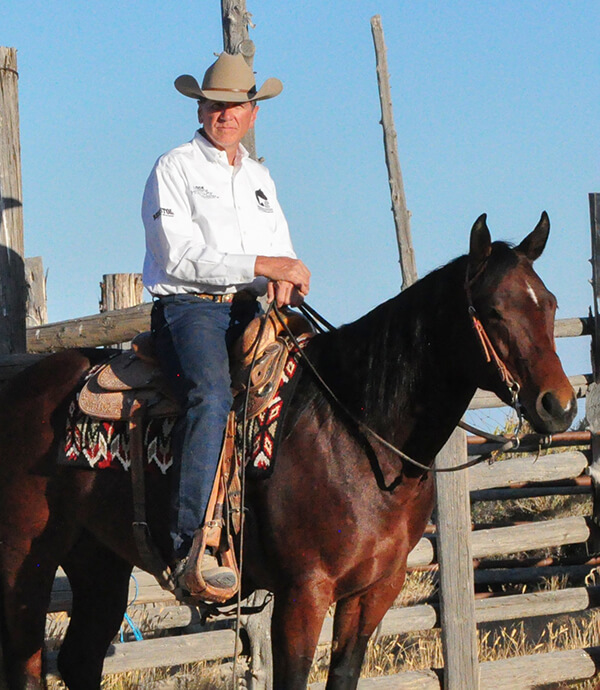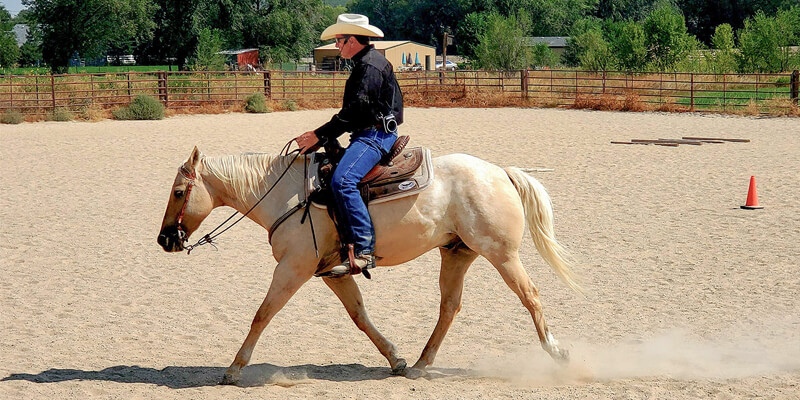Ranch Riding Exercises for Connecting with Your Horse
Ranch Riding competitions promote the athletic ability and versatility of a ranch-style horse. As both a judge and a trainer/clinician I’m going to give you a few tips that will help you develop your horse’s ability to work at a forward, working speed while still under your steady control as a rider.
Ranch Riding judges are looking for a horse that is well-trained, relaxed, quiet, soft, and cadenced at all gaits. Your horse should be able to navigate a pattern in a correct and efficient manner. Ideally, a ranch horse will travel with forward movement, ridden with light contact on a relatively loose rein.
Circle Exercises
Let’s start with an exercise I like to do with all my training horses and in my lessons. This exercise helps with building “guide” and getting the horse to relax. It also strengthens a horse’s muscles.
Circle exercises are great for working on your feel of the horse’s body position, as well as your own body position. This is necessary to keep the horse traveling where you want. It may sound easy to walk in a circle but to keep your horse on a very specific track takes time. You need to develop the feel and body control necessary to keep your horse in a consistent bend.
First, a key thing about circles is that they are round. All points in the circle are the same distance from the center. They are not ovals nor are they egg-shaped. Circles don’t have straight lines or corners.
When beginning to ride a circle it may be useful to place a cone or a barrel at the center as a visual. It may help to walk the circle perimeter on foot to mark your circle. Attach a 10- or 15-foot-long rope to your center and walk the perimeter several times, making a distinct track in the sand. Once you have a good circle pattern in the sand you can use that track to follow when you ride.
When riding a circle, your horse’s bend should be throughout their body and in the direction of the circle, from head to hip. Use your legs and, to a lesser extent, your hands to help maintain the bend. If your horse drifts to the inside of the circle use your inside leg and rein to move them out onto your track. If the horse drifts outside of the track, use your outside leg and rein to block that movement and to bring them back to the circle track.
Looking in the direction that you’re riding helps to correctly position your entire body and guide your horse. Move your head and shoulders so you are looking ahead about a quarter of the circle; you should be able to begin feeling your horse moving in the direction you are looking.
Start out riding your circles at the walk which also helps to warm up a horse’s muscles and joints. Once you have a good consistent circle going one way, reverse and go the other direction, paying attention to see how it feels compared to the first direction. Just like us being right or left-handed, horses have a stronger and weaker side. Once we recognize which side is harder for them, then we can work more on strengthening (developing) that side so our horses become more balanced.
Add Speed
When you and your horse are consistently going around the circle at a walk, move up to a trot on the same circle. As you increase speed, deviations to the circle will happen more quickly so be prepared to make necessary corrections sooner to keep your horse on the correct track. Work one direction until you and your horse feel comfortable, then change directions and work the other side of your horse.
Once you feel accomplished with circles at the walk and the trot you are ready to lope circles. For this you will need to follow the same process above to create a visual 50- or 60-foot diameter track in your arena sand that you can follow. Ideally, you may want to start out by loping along the rail first to get any extra energy out so you and your horse will be ready to focus. When we ride, it’s important to remember that, like the horse, we’re not equally balanced nor strong in both directions. Riding circles is an opportunity to pay attention to and strengthen our body position and balance. As we work on helping our horses to be more supple and balanced, we always need to be working on these skills in ourselves, as well. Riding this circle exercise at least once or twice a week will help the rider and horse develop stronger muscles, skills, and relationship—all useful, whether you plan to show or not.
See this article in the November/December 2022 online edition:
Nov/Dec 2022

Matt Livengood is a seasoned reining and ranch riding competitor who holds judging certifications with NRHA, NRCHA, AQHA specialty, and ASHA. He teaches riders and horses about ranch riding and ranch versatility, as well as groundwork and starting Mustangs. Matt has competed in four Mustang Makeover events, reaching the finals in all four and winning both the 2017 Reno Extreme Mustang Makeover and the 2019 Mustang Madness freestyle in Cle Elum, WA.
Matt has judged numerous Extreme Mustang Makeovers, including virtual shows. He’s been an NRHA judge since 1999, judging shows across North America each year, including A and AA shows. In 2020, he judged at the AQHA World Show in both reining and ranch riding. Matt teaches and trains from his home, Sweet Pepper Ranch (sweetpepperranch.com) in Nampa, ID. Call 206-909-0511 or email [email protected].





